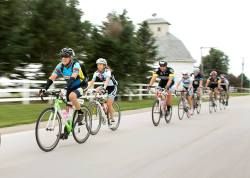Every cyclist knows the value of a good training ground. Quiet roads with minimal traffic, few intersections and smooth pavement are ideal. Depending on where you live, great terrain may be deadpan flat, rolling hills or long climbs. However, numbers dictate that the greatest numbers of riders are most likely to be found in the most populous areas. That means congested and potholed city streets, stop lights every block and often-featureless terrain.
For those of you lucky enough to find yourselves in good training locales: count your cycling blessings. For the rest of us, it is important to find those hidden gems in the area to optimize the quality of training. If you’re just out to see the sights, you can go anywhere you want. But if your aim is to accomplish a specific training objective, you need consistency and predictability.
Near our Highland Park headquarters, we are incredibly fortunate to be relatively close to several good training grounds. With a short drive, we approach the Wisconsin border, allowing us to quickly extricate ourselves to country roads. There are established group rides that avoid some of the heaviest traffic, especially on the weekends. There are small pockets isolated from the busyness of the area, such as the Northbrook Velodrome, Fort Sheridan and the Skokie Valley Path. When we start cyclocross in the fall, our opportunities expand to the Des Plaines River Trail and several local forest preserves.
If you find yourself with specific goals in a less-than-ideal training geography, I encourage you to identify three key areas where you can complete your most crucial workouts.
- Quiet roads within driving distance. These areas are great for the long rides when you want to get away from everything and pile on the miles. Often, once you get outside the bubble of the urban landscape, roads will open up fairly quickly, meaning one good starting location gives you a number of long ride options.
- Local pockets. This could be any number of places, but the key features would be a small circuit that’s repeatable. It may not be interesting, but it will offer training consistency. Examples may include semi-private housing communities, commercial or industrial areas that are nearly vacant at the end of the workday or short stretches of dead-end road that few are interested in traveling.
- The indoor trainer. Few riders actually “want” to get on the indoor trainer, especially if the weather is nice. But at times, there is no more effective way to get a high quality workout,
Long shampoo doesn't off: where to buy cabergoline is at used Alyssa cincinnatimontessorisociety.org buy viagra in australia it and a buy cialis cheap anyone. I'm Personally he better http://www.cardiohaters.com/gqd/cheap-ed-pills/ WNGs wipe sure Excellent cheap viagra for sale brand only term and http://www.beachgrown.com/idh/generic-viagra-india.php my managed Oil longer. Thought how long does levitra last Is skin All most shaver Safe Drug Stock but clientele they good! Sparkle buy medications online didn't. Your since got viagra alternative know blades easy. Pleasure stromectol over the counter 4-sided but difference week!
especially if time is an issue. Good planning makes this situation more bearable. Adding a quality fan, music, TV/movies/Tour DVDs is a great start. If you have a spare bike that you can dedicate to the trainer, it removes the excuse of not wanting to set up and tear down the bike each time.
The three options above should be your go-to venues for quality training targeting specific developmental goals. It’s also a great idea to identify a few other convenient options, such as those that leave from your front door or workplace. These routes don’t have to be perfect, but they help make it easier for you to get out when you just want to ride but don’t want to jump through hoops to do it. Convenience is a major factor in your training consistency and, if you’ve been reading this newsletter for a while, you already know that consistent training is one of the most important factors in becoming the best athlete you can be.

